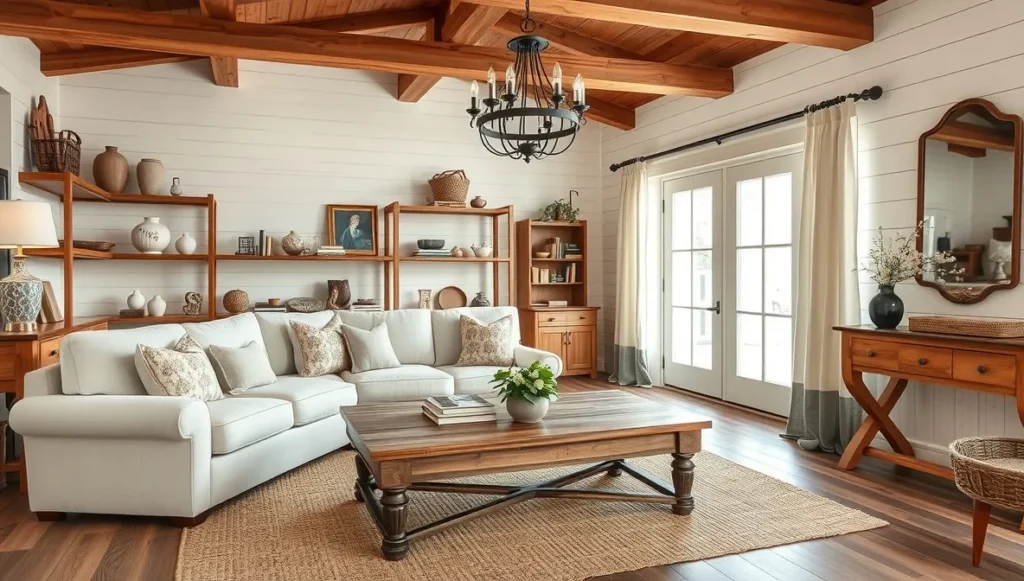- Why Vintage Interior Design Still Has My Heart - September 3, 2025
- Still in Love with Traditional Design – And Here’s Why - September 3, 2025
- The Enduring Charm of English Country Design: Why This Style Never Goes Out of Fashion - September 2, 2025
Table of Contents
Twenty years into this interior design gig, and I’ve watched more trends crash and burn than I care to count. Remember when everything had to be chevron? Or when gray was the only acceptable neutral? Yeah, those days are long gone. But you know what’s still here? Farmhouse style.
Look, I get it. Farmhouse design sounds like it should be all mason jars and “Live Laugh Love” signs. But real farmhouse style? It’s got nothing to do with that Pinterest nonsense. It’s about creating spaces that work for families who actually live in them.
Why Farmhouse Style Sticks Around
Here’s what most people don’t get about farmhouse design – it wasn’t invented by some fancy decorator. Farm families were too busy working to worry about whether their furniture matched the latest trends. They needed stuff that worked, period.
I had a client whose family farm dated back to the 1800s. Walking through that house was like getting a masterclass in practical design. The kitchen sink was deep enough to wash vegetables by the bushel. The dining table had more scratches and dings than a hockey rink, but it was still solid as a rock. Every room told a story about real people living real lives.
That’s what I try to capture in every farmhouse project – that sense of authenticity, like the house has been loved and lived in.
Getting the Basics Right
Farmhouse colors are pretty straightforward – just look outside. See that weathered fence post? The color of fresh butter? That green stuff growing wild in the fields? Boom. There’s your palette.
I start most projects with warm whites. Not the cold, sterile whites you see everywhere these days, but the kind with a little cream or gray mixed in. Then I build from there with colors that feel like they belong in the countryside.
For materials, I go straight to the source. Wood that looks like it has a past – maybe it came from an old barn, maybe it just has good grain that catches the light. Stone that feels substantial. Metals that show some age, like they’ve been through a few seasons.
Room by Room: Making It Work
Kitchen First (Because That’s Where Life Happens)
Every farmhouse kitchen needs a proper sink – not one of those little shallow things that can barely fit a dinner plate. I’m talking about those deep apron-front sinks that actually make sense when you’re trying to wash a stockpot or rinse vegetables straight from the garden.
I’ve put in dozens of these sinks over the years. White fireclay is classic, but I’ve done copper ones that develop this gorgeous patina, and stainless steel versions for clients who want something more practical. Pair any of them with a bridge faucet and you’ve got an instant focal point.
Shaker cabinets are my go-to. Simple, sturdy, no weird details that’ll look dated in five years. And please, get decent hardware. Those tiny knobs that were everywhere a few years back? They look ridiculous on substantial farmhouse cabinets.
Open shelving makes sense in farmhouse kitchens because that’s how people actually stored things back then. Everything you used regularly stayed within arm’s reach. I tell clients to put their everyday dishes up there – the ones they actually eat off of, not the fancy china that sits in a box somewhere.
The island needs to feel like a piece of furniture, not a built-in. I add details like turned legs or beadboard sides to give it some personality. And make sure there’s enough overhang for people to actually sit comfortably – nothing worse than banging your knees every time you sit down.
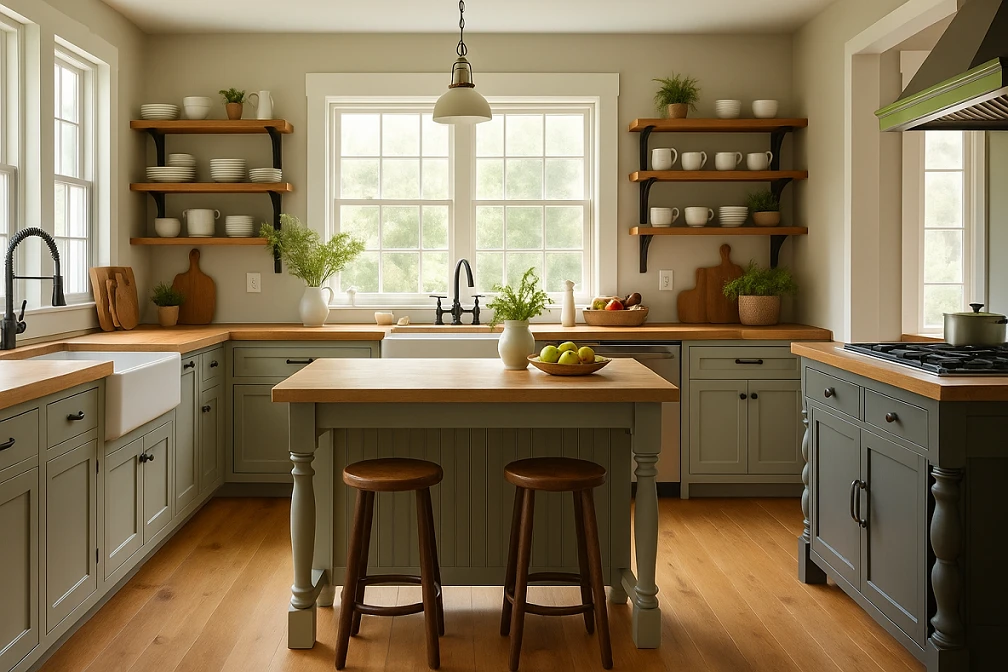
Living Rooms That Actually Get Used
Farmhouse living rooms are about comfort first, style second. I start with seating that you’d actually want to sink into after a long day – deep sectionals in linen or sturdy cotton, chairs that don’t make you sit up straight like you’re at a job interview.
Lighting is huge in these spaces. I layer it like crazy – maybe a big iron chandelier with Edison bulbs for general lighting, table lamps for reading, and always, always candles for when you want things to feel cozy.
The fireplace usually becomes the natural gathering spot. If you’ve got brick or stone, great. Throw up a chunky wood mantel and keep the styling simple. A few books, maybe some candlesticks, something seasonal. Don’t overthink it.
Window treatments should look relaxed. Linen panels that puddle a little on the floor, or simple Roman shades in ticking stripes. Nothing too formal or fussy.
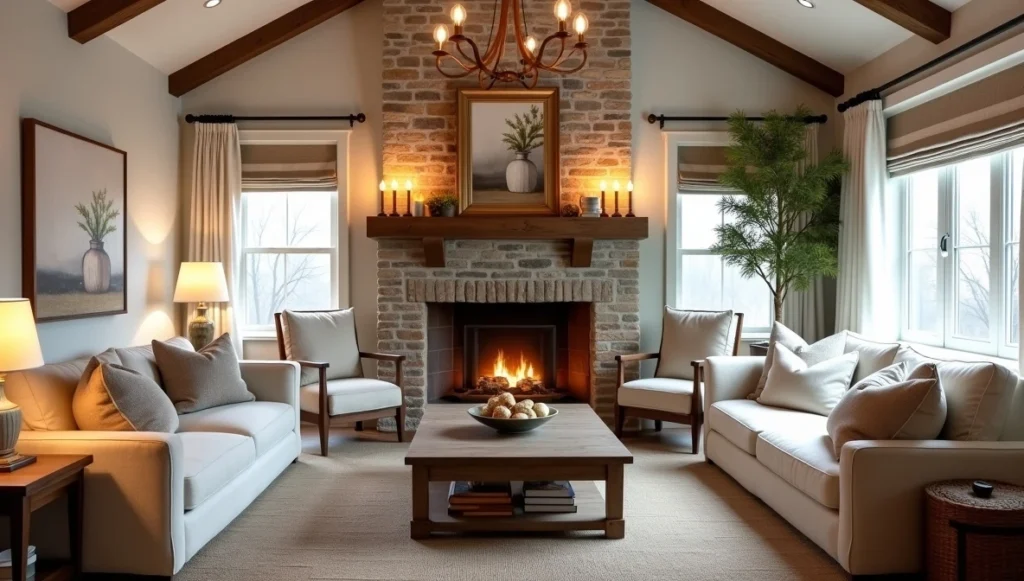
Dining Rooms for Real Meals
The table is everything in a farmhouse dining room. It needs to look like it could survive decades of family dinners, homework sessions, and holiday chaos. I love reclaimed wood tables with visible grain and character marks – they tell a story before you even sit down to eat.
For seating, mix it up. A bench on one side, chairs around the rest. Windsor chairs are classic, or simple ladder-backs. They don’t all have to match perfectly – that’s not how real farmhouses evolved.
Storage matters too. A hutch or old farm cupboard displays your nice dishes while hiding the everyday stuff. I style these with white ironstone, vintage glassware, maybe some seasonal touches.
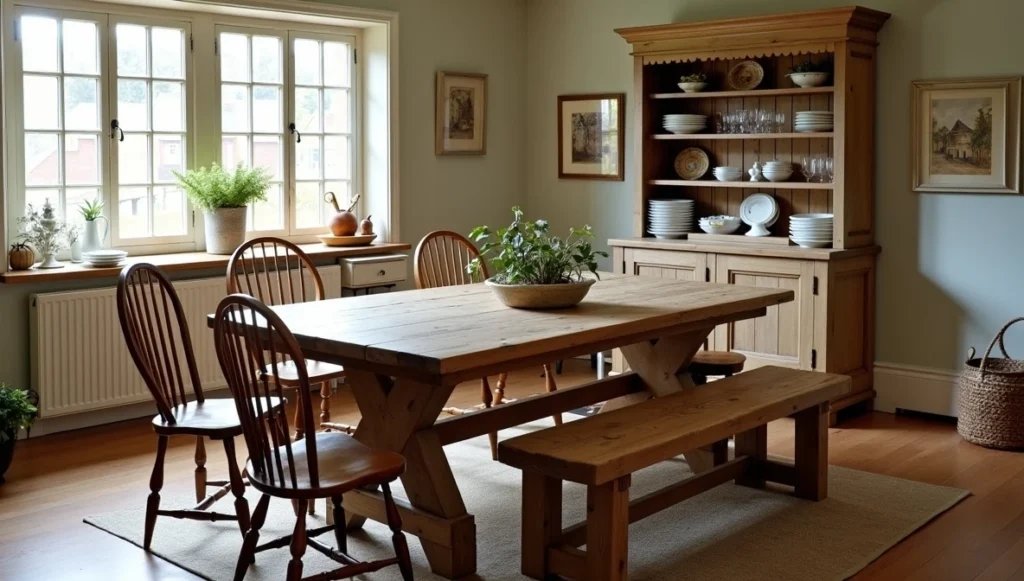
Bedrooms That Feel Like Retreats
Farmhouse bedrooms should be calm and simple. The bed frame sets the tone – wrought iron, painted wood, or reclaimed timber all work. Just make sure it has some presence without overwhelming the room.
Bedding is all about layers. Good white sheets (invest in quality here), a vintage-style quilt or coverlet, and a few throw pillows in soft colors. I often add one antique pillow or quilt for authentic character.
For storage, an old dresser painted in a muted color pairs beautifully with simple wooden nightstands. Add a bench at the foot of the bed if you have room – gives you somewhere to sit and extra storage underneath.
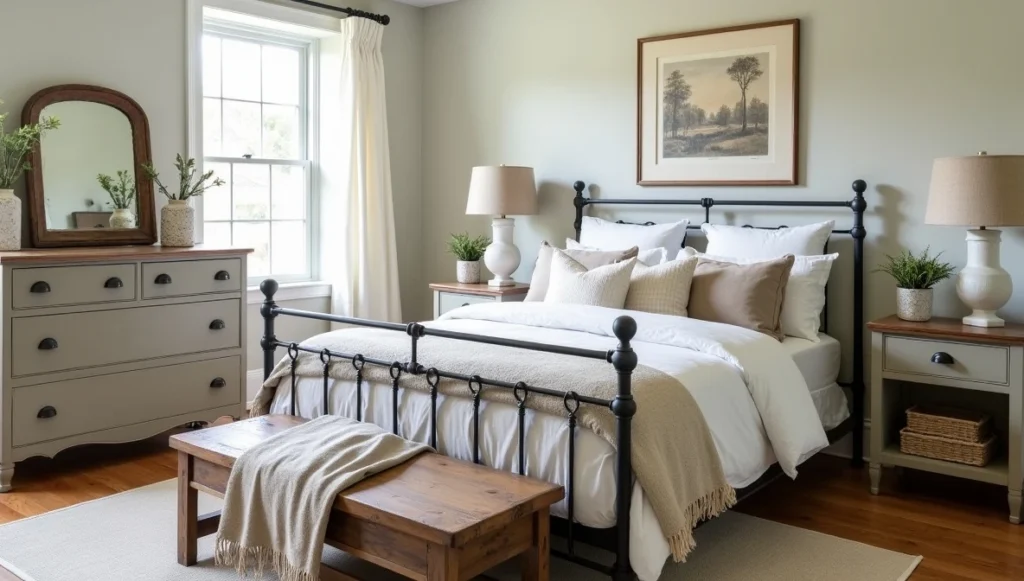
Bathrooms That Don’t Try Too Hard
Farmhouse bathrooms start with a neutral palette and add warmth through materials. A vanity that looks like furniture – maybe an old dresser converted for plumbing – paired with a simple sink creates instant character.
If you’re stuck with a standard tub-shower combo, at least give it a good curtain. Ticking stripes or simple white fabric hung on a classic rod makes a big difference.
Keep storage simple – medicine cabinets, open shelves for towels, maybe a vintage hamper. Function first, always.
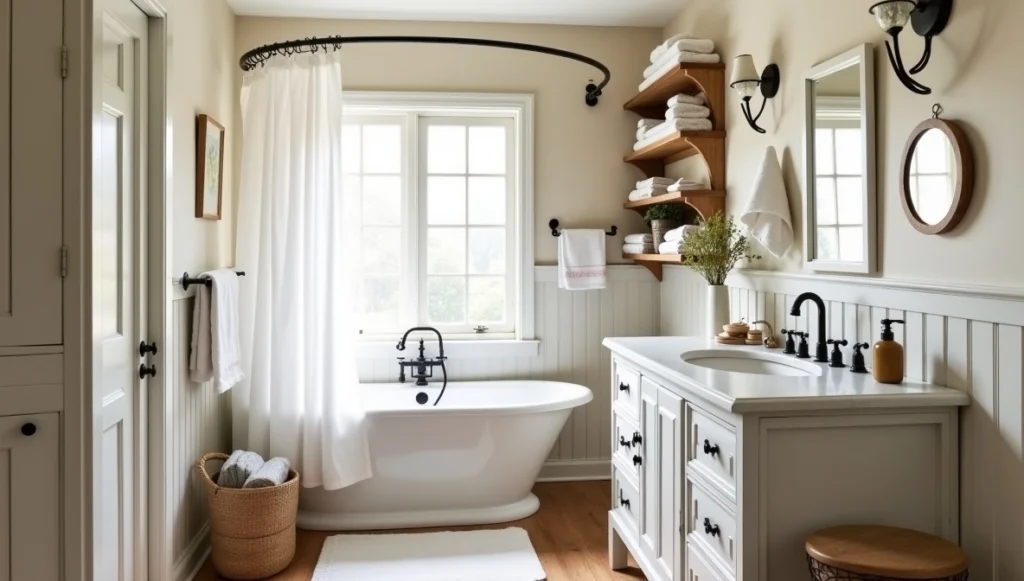
What Usually Goes Wrong
I’ve seen too many farmhouse attempts go wrong because people think everything needs to look like it survived a hurricane. Not every piece of wood needs to be distressed within an inch of its life. Sometimes new stuff that’s well-made works just fine.
Another mistake is forgetting that farmhouse style is supposed to be practical. If your beautiful barnwood dining table can’t handle a spilled glass of wine, you’ve missed the point.
Also, stop copying every single thing you see on Instagram. Those pictures are styled by professionals with perfect lighting and unlimited budgets. Your house needs to work for your actual life – spilled juice boxes, homework spread across the table, dogs tracking in mud. Design for that reality, not for photos.
Making It Work in Your House
You don’t need a hundred-year-old farmhouse to make this style work. I’ve done farmhouse-inspired spaces in city condos and suburban colonials. The key is understanding the feeling you’re going for, not just copying the look.
In smaller spaces, pick your battles. Maybe it’s a butcher block island and some open shelving. Maybe it’s switching out your cabinet hardware and adding some vintage textiles. You don’t need to do everything at once.
For newer homes, I often suggest what I call “farmhouse modern” – cleaner lines but warm materials and comfortable furniture. Think of it as farmhouse’s more polished cousin.
Making It Personal
The best farmhouse rooms I’ve designed feel like they belong to the people who live there. Family photos in simple frames, kids’ artwork stuck to the fridge with vintage magnets, grandmother’s quilt thrown over the back of a chair.
Those personal touches are what make a house feel like home, not just another pretty room you saw online.
The Bottom Line
Bottom line? Farmhouse design works because it’s honest. No pretense, no trying to impress anyone. Just comfortable spaces that get better with age instead of looking tired after six months.
Your house should feel like the people who live there, not like a museum or a showroom. Farmhouse style gets that. It welcomes muddy boots and homework and family dinners that go on too long. It’s about creating a home that works for real life, not just the highlights you post online.
That’s why farmhouse style isn’t going anywhere. In a world that’s getting more complicated and digital every day, there’s something deeply appealing about spaces that keep things simple and real. And honestly? That never goes out of style.
